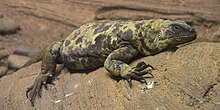San Esteban chuckwalla
| San Esteban chuckwalla | |
|---|---|
 |
|
| Scientific classification | |
| Kingdom: | Animalia |
| Phylum: | Chordata |
| Class: | Reptilia |
| Order: | Squamata |
| Suborder: | Iguania |
| Family: | Iguanidae |
| Genus: | Sauromalus |
| Species: | S. varius |
| Binomial name | |
|
Sauromalus varius Dickerson, 1919 |
|
The San Esteban chuckwalla (Sauromalus varius), also known as the piebald chuckwalla or pinto chuckwalla, is a species of chuckwalla belonging to the family Iguanidae endemic to San Esteban Island in the Gulf of California. It is the largest of the five species of chuckwallas and the most endangered.
The generic name, Sauromalus, is a combination of two Ancient Greek words:σαῦρος (sauros) meaning "lizard" and ομαλυς (omalus) meaning "flat". Its specific name varius is Latin for "speckled" in reference to the chuckwalla's mottled coloration. It was first described by American herpetologist Mary C. Dickerson in 1919.
The common name chuckwalla derives from the Shoshone word tcaxxwal or Cahuilla caxwal, transcribed by Spaniards as chacahuala. The Seri people named originally the island for this species: Coftécöl lifa or the Peninsula of the Giant Chuckwalla.
The San Esteban chuckwalla is endemic to San Esteban Island in the Gulf of California. While it is abundant on this small island, it occurs naturally nowhere else and is protected under the Endangered Species Act. At one time, the Seri translocated populations of this lizard to other islands in the Sea of Cortés as a food item, but none of these populations has survived beyond the original population found on San Esteban.
Harmless to humans, these large lizards are known to run from potential threats. When disturbed, the chuckwalla wedges itself into a tight rock crevice, gulps air, and inflates its body to entrench itself.
Males are seasonally and conditionally territorial; an abundance of resources tends to create a hierarchy based on size, with one large male dominating the area's smaller males. Chuckwallas use a combination of color and physical displays, namely "push ups", head-hobbing, and gaping of the mouth to communicate and defend their territory.
...
Wikipedia

